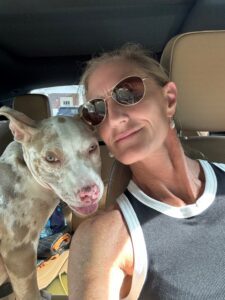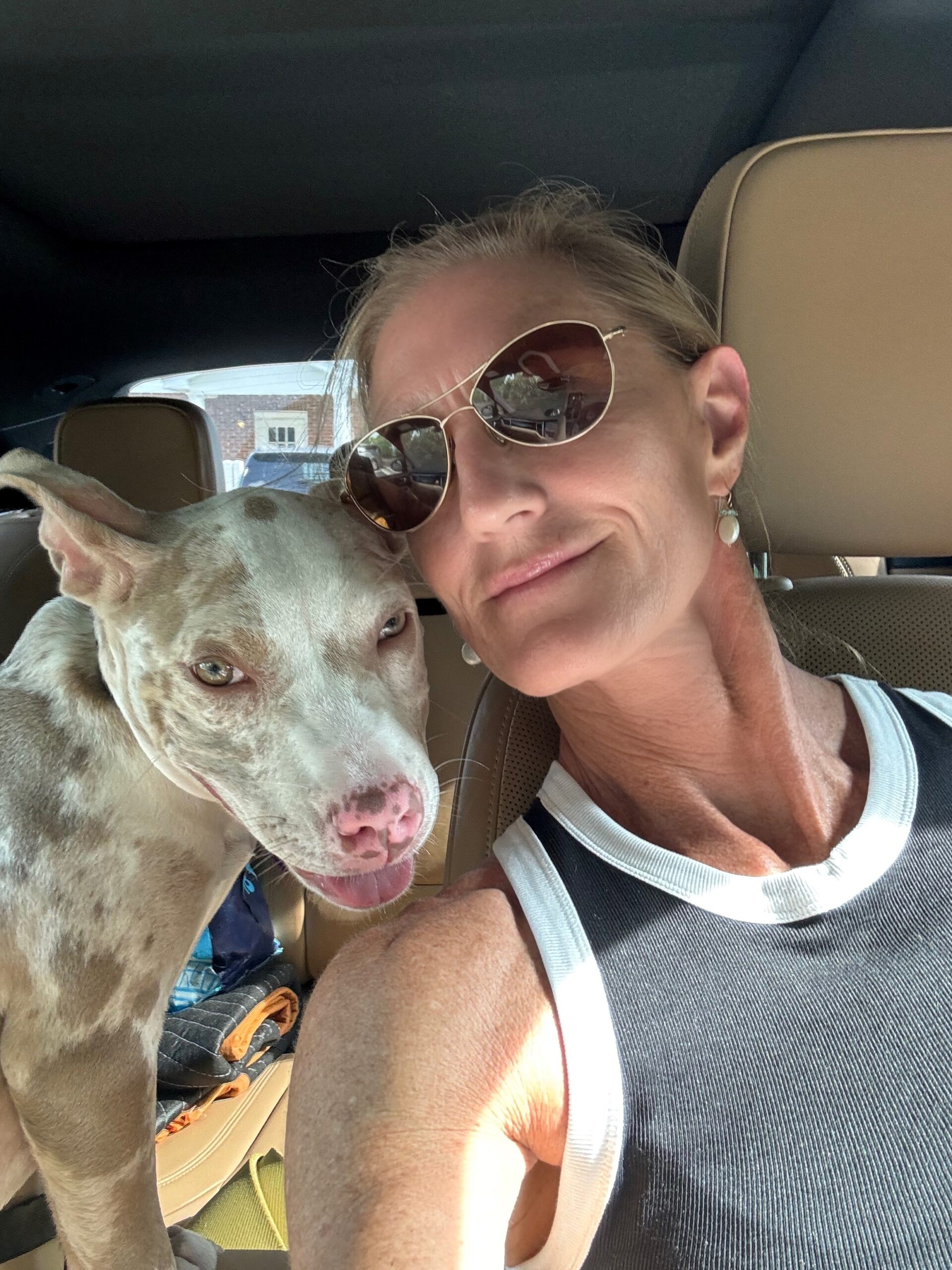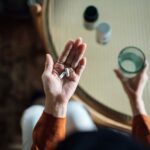 Paige Bottom, CEO of Iron Bridge, welcomes my request for an interview. We meet each other on Zoom, me in my sunroom, Paige outside at the Iron Bridge facility, the wind ruffling her hair and an expanse of blue sky in the background. It’a beautiful day in Chester, Virginia, and Paige loves to be outdoors. She radiates energy and enthusiasm, and as we talk, her love for Iron Bridge, her staff, and her clients becomes evident.
Paige Bottom, CEO of Iron Bridge, welcomes my request for an interview. We meet each other on Zoom, me in my sunroom, Paige outside at the Iron Bridge facility, the wind ruffling her hair and an expanse of blue sky in the background. It’a beautiful day in Chester, Virginia, and Paige loves to be outdoors. She radiates energy and enthusiasm, and as we talk, her love for Iron Bridge, her staff, and her clients becomes evident.
Paige, who has spent the last 25 years of her career in leadership positions at mental health and substance use facilities across the country, has been with Iron Bridge since the facility opened in the fall of 2023. Building a facility from the ground up is something Paige loves to do.
“This was such an exciting opportunity for me,” she says. “I love the opportunity to just create [a facility] from the beginning, to look at culture and space and how the environment fits in with everything that we’re doing.”
Paige and her team are committed to creating at Iron Bridge a culture of acceptance–of the clients themselves, of their families, and of the Chesterfield County community at large. “There is still such a significant stigma around substance use disorder and mental health, even within people in our own field. It is of the utmost importance to have an environment that feels respectful, that feels warm, that’s inviting, that’s clean, that says to the patient ‘you matter.’”
Connection, Safety, and Beauty
Clients at Iron Bridge come from diverse racial and socioeconomic backgrounds, which is an asset to their treatment experience. “Connection in recovery is the most important thing,” Paige shares. “Addiction is isolative–part of what keeps the disease alive is feeling separate from people, from yourself, from the community, from God, from whatever is most important.”
Iron Bridge helps clients build connections and community through group work. Group sessions help people see themselves in each other, even when surface differences are so apparent. As Paige puts it, “The 19-year-old woman and the 63-year-old man can see that they have something in common, and they can build on that and lean into each other’s strengths.”
Iron Bridge’s welcoming aesthetic helps people feel comfortable with each other. Paige describes how the rooms, the outdoor spaces, and the layout all contribute to a feeling of safety and beauty: “I’m sitting right now in this beautiful enclosed courtyard [she changes the camera angle to show me a vast green lawn bordered by a white fence and trees]. We haven’t fully utilized it yet, but we have a volleyball net, and we’ll be putting more games and activities out here. We’re going to build a meditation labyrinth.”
Compassion and Expertise
I ask Paige what has been the most challenging part of her work here. She pauses in thought. “Hiring the right staff and keeping the right staff,” she says. “This is hard work that we do. People come here with the best of intentions and sometimes it’s just not a good fit, you know? You have to have thick skin, you gotta have a lot of patience and understanding, and it’s not easy work.” While they had a fairly high turnover for the first few months, the team has stabilized now, and Paige credits them for helping create a culture of acceptance.
“You have to meet the patient where they are in the process, and then just be willing to walk alongside them,” she says. “That requires having staff that are well trained and well educated in addiction and mental health. That’s the culture we’re building: compassion and expertise.”
Motivation to Change
In 2022, 81 people in Chesterfield lost their lives from a drug overdose, which was a 36.7% decrease in the total number of fatal overdose deaths in Chesterfield since 2021. This is good news, but in Virginia as a whole, fatal drug overdoses have been the leading unnatural cause of death since 2013. For people who have not experienced addiction directly, recovery might seem to be a simple matter of willpower. Just stop using substances, right?
But addiction is a chronic disease that changes how the brain functions. Many people who come into treatment are the sickest they’ve ever been–and still they have limited motivation to get well. That’s part of what makes treatment so challenging. “Most people who come into this level of care are in what we call a pre-contemplation stage of change,” Paige explains. “They’re here because of some external pressure–parents, spouse, work, the justice system, whatever. External motivation is sufficient to get you here, but it’s not sufficient to keep you sober.”
Paige takes it as her responsibility to help people find their passion for the recovery journey. “Once they get to that place,” she says, “the sky’s the limit. But the path to internal motivation is tough! Addiction is a powerful and fatal disease. There’s a constant pull back into the illness.”
Caring for the Soul
One way the Iron Bridge team helps clients find personal motivation for recovery is through holistic programming, what Paige calls a “holistic expressive arts component.”
[PUPPY INTERRUPTION: Paige gets distracted as a little brown and white head nudges itself under her arm. “This is Fiona,” Paige laughs. “She’s new to me and not very well behaved yet.”]
The facility offers yoga and meditation, as well as “clay work” and other crafts, gardening, and now equine therapy at a nearby stable. Paige loves the way expressive arts can inspire clients and help them engage. The arts “get at addiction without coming straight at it,” she says.
For example, one project therapists ask clients to do is to “represent your addiction in clay” or “represent in clay what you want your recovery to look like.” One client sculpted a lion (“I want my recovery to be strong and to roar!”). Another project is to paint masks that represent the faces of addiction and recovery. Therapists use these projects to help clients talk about how to bridge the gap between their old self and their new self.
“The clients love it,” Paige says. “They can’t see beyond their addiction when they get here. So our responsibility is to help them see the possibilities.”
Getting Personal
Paige’s passion for her work comes in large part from her own experience in addiction recovery. She’s been in recovery since 1988, and I asked her what has been the key to her success.
“Oh my goodness!,” she begins. “It has changed over the years…I got sober because I was in a lot of pain, I had lost everything that mattered to me–all of the reasons that most people end up in treatment. But as you grow in your recovery, all these other things begin to open up. It’s like the Promises in the Big Book of AA. The promises come true after you have been working a particular recovery program; you can all of a sudden see that there will be joy and love and connection and all those things.
So for me it’s been about that. It’s been about beauty, possibility, love–on the big scale, the Big Love kind of thing–and then having the opportunities to watch other people find all of that–that’s a really special thing. You know, I love our clients.”
For all that Paige loves Iron Bridge and the work she does there, what does she do when she’s not at work?
“I practice yoga on a regular basis. I’m a gym rat, like that has kept me sane. When I first got sober, that’s where I spent a lot of my energy and my focus–I was a runner, I was in the gym all the time, and then eventually I was introduced to yoga. I spend time with this little creature [she points her camera to Fiona lolling on the grass]. I spend a lot of time hiking outdoors with friends and family. I moved back to Virginia because my parents are aging, and it was time to re-establish that connection in a more physical way.”
If you or a loved one are struggling with addiction or with a dual diagnosis, Iron Bridge can help. “I’m just grateful that people have the opportunity to come to a place that is safe and supportive and can help them make a change,” Paige says. “It’s good stuff.”





